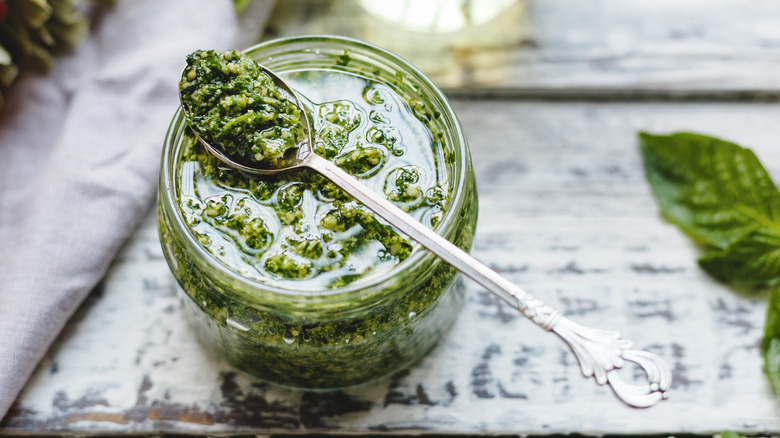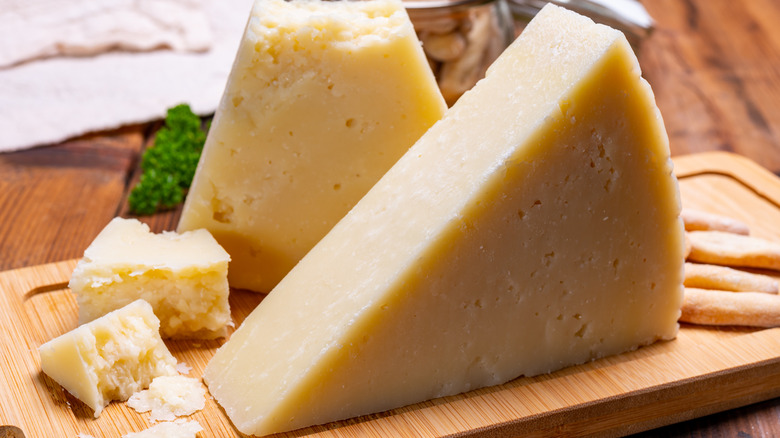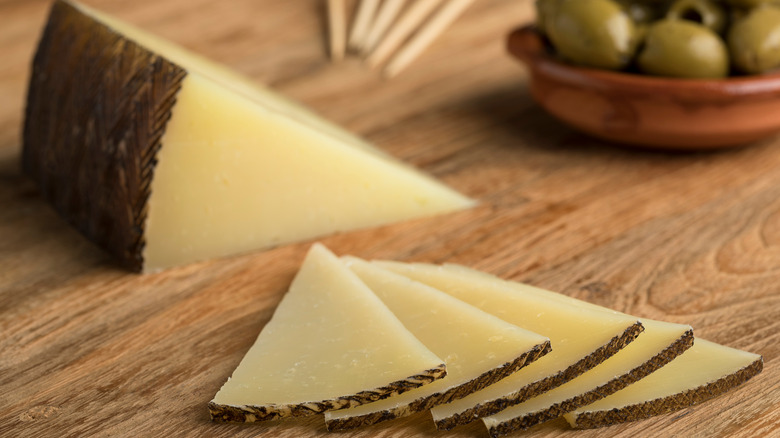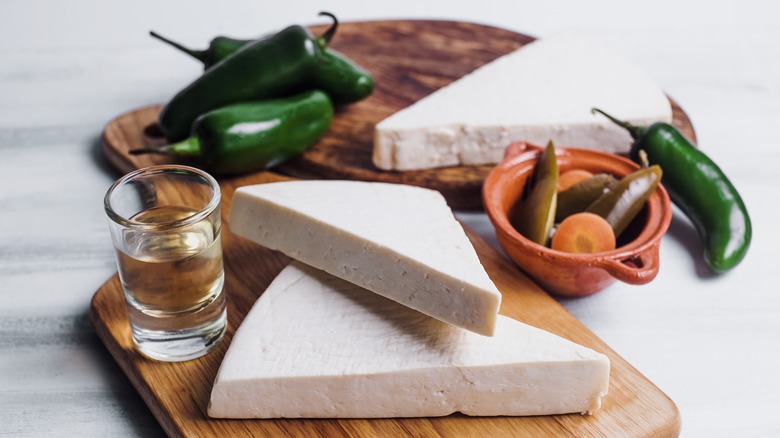The Cheeses You Can Use Instead Of Parmesan For Pesto
If you're say, purely hypothetically, a kid who grew up in the Mid-South in the 1990s and your only contact with Italian cuisine came from a bottle of Prego, Domino's delivery, and, rarely, a hefty slice of lasagna, then pesto was likely a revelation to you. In the narrow library of sauces and condiments that could be purchased in bottles and packets at the Kroger supermarket back then, pesto had no equal.
Pesto has so many angles: bright, herbaceous basil; pungent, assertive garlic; luscious olive oil; deeply savory Parmesan; toasty pine nuts. Bathing fusilli pasta, roasted chicken, or just smeared on crusty focaccia, pesto seems to awaken everything it comes in contact with.
But one problem pesto poses is that Parmigiano-Reggiano can be pricey, with a single wheel of the aged cheese regularly retailing for more than $1,000, according to Insider. That's because of the time and amount of raw product needed to produce it. A wheel begins life, in part, as 131 gallons of milk and needs a minimum of 12 months of aging before it can be sold, but is often aged for years more (via Food & Wine) Luckily, there are a bevy of cheeses that can stand in for Parmesan, either as a cheaper alternative or as a means to add a little variety and depth to your pesto game.
Pecorino Romano
One of the first cheeses that jumps to mind is Pecorino Romano. As Cheese.com explains, Pecorino Romano is a sharp sheep's milk cheese that has been produced since the ancient Roman era, as the name implies. It is more pungent and has a more pronounced bite as compared to Parmesan, so Pecorino Romano produces a punchier pesto that can stand up to bold flavors such as steak and red wine.
The pronounced flavor of this Italian cheese is on display in this recipe from Martha Stewart. She steps up the pesto by swapping out bitter parsley for the basil and omitting pine nuts altogether. Stewart suggests this as a great sauce for roasted potatoes and grilled meats, such as beef, chicken, or lamb chops.
Food & Wine offers another take on pecorino pesto, this one used in a pasta dish of orecchiette and ripe tomatoes. Their pesto does make use of nuts — salted almonds this time — and allows for the pecorino to be swapped out for its lesser-known, but close-in-flavor Sardinian cousin, Fiore Sardo.
Manchego
Another sheep's milk stand-in, this one from Spain, is Manchego. Normally served as is with membrillo, aka quince paste, this cheese is a staple of charcuterie boards, cheese plates, and tapas bars. While Manchego is not quite as dry and crumbly as Parmesan, it still incorporates well in pesto. Serious Eats' guide to Manchego explains that this cheese, protected by Spanish DOP and European PDO designations, is made exclusively from sheep of the Manchega breed. It is said that this is responsible for Manchego's signature richness as sheep's milk has around double the butterfat as that of cows and goats.
You can stick with the Spanish theme in a recipe for Manchego pesto, subbing buttery Marcona almonds for pine nuts, sharp arugula for basil, and adding in lemon zest. It all adds up to a sauce that is bright and zippy, but with enough backbone to splash on grilled shrimp and stir into pasta, tomato, and olive dishes.
Cotija
For a pesto that is well outside the box, you may want to turn to cotija. An aged Mexican cheese, cotija is just as salty as Parmesan, but boasts a fresher flavor more redolent of whole milk, according to Bon Appétit. It is the go-to cheese for elote, grilled corn that is slathered in mayo and chile powder before being dusted with cotija and spritzed with lime juice. You can find an assortment of cotija varieties at Mexican grocery stores, from the moist, young variety to finely-aged cheese that is sometimes sold pre-grated like Parmesan.
Serious Eats doubles down on the Mexican flavors with a pesto that not only incorporates cotija, but swaps basil for cilantro, creating a unique flavor profile that is vegetal and tart. Pine nuts defer to pumpkin seeds, or pepitas, which are used in many Mexican recipes to thicken and enrich sauces. Finally, lime juice gives this pesto the balance it needs with a tart sweetness.
We know cheese doesn't agree with everybody. If you're in the fromage-free club but still want to get down with herby sauces, there are plenty of options. The natural choice would be chimichurri, the Argentinian wonder sauce that leverages the bite of parsley, chili flakes, and red wine vinegar to electrify grilled meats and vegetables. We love this recipe from chef John Manion, owner of El Che Bar & Steakhouse, shared with Chicago Magazine. Or, give this Vietnamese-inspired pesto with peanuts, brown sugar, mint, and fish sauce a try (via Saveur.)



